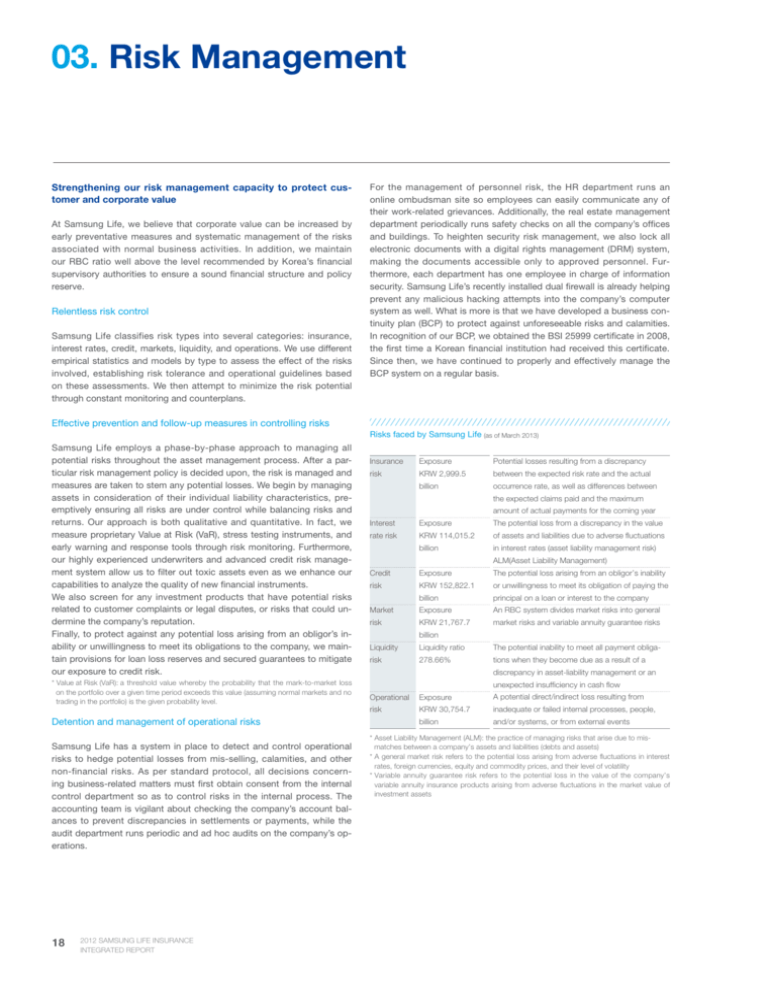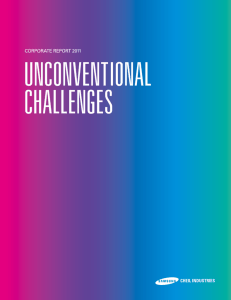03. risk management
advertisement

03. Risk Management Strengthening our risk management capacity to protect customer and corporate value At Samsung Life, we believe that corporate value can be increased by early preventative measures and systematic management of the risks associated with normal business activities. In addition, we maintain our RBC ratio well above the level recommended by Korea’s financial supervisory authorities to ensure a sound financial structure and policy reserve. Relentless risk control Samsung Life classifies risk types into several categories: insurance, interest rates, credit, markets, liquidity, and operations. We use different empirical statistics and models by type to assess the effect of the risks involved, establishing risk tolerance and operational guidelines based on these assessments. We then attempt to minimize the risk potential through constant monitoring and counterplans. For the management of personnel risk, the HR department runs an online ombudsman site so employees can easily communicate any of their work-related grievances. Additionally, the real estate management department periodically runs safety checks on all the company’s offices and buildings. To heighten security risk management, we also lock all electronic documents with a digital rights management (DRM) system, making the documents accessible only to approved personnel. Furthermore, each department has one employee in charge of information security. Samsung Life’s recently installed dual firewall is already helping prevent any malicious hacking attempts into the company’s computer system as well. What is more is that we have developed a business continuity plan (BCP) to protect against unforeseeable risks and calamities. In recognition of our BCP, we obtained the BSI 25999 certificate in 2008, the first time a Korean financial institution had received this certificate. Since then, we have continued to properly and effectively manage the BCP system on a regular basis. Effective prevention and follow-up measures in controlling risks Risks faced by Samsung Life (as of March 2013) Samsung Life employs a phase-by-phase approach to managing all potential risks throughout the asset management process. After a particular risk management policy is decided upon, the risk is managed and measures are taken to stem any potential losses. We begin by managing assets in consideration of their individual liability characteristics, preemptively ensuring all risks are under control while balancing risks and returns. Our approach is both qualitative and quantitative. In fact, we measure proprietary Value at Risk (VaR), stress testing instruments, and early warning and response tools through risk monitoring. Furthermore, our highly experienced underwriters and advanced credit risk management system allow us to filter out toxic assets even as we enhance our capabilities to analyze the quality of new financial instruments. We also screen for any investment products that have potential risks related to customer complaints or legal disputes, or risks that could undermine the company’s reputation. Finally, to protect against any potential loss arising from an obligor’s inability or unwillingness to meet its obligations to the company, we maintain provisions for loan loss reserves and secured guarantees to mitigate our exposure to credit risk. *Value at Risk (VaR): a threshold value whereby the probability that the mark-to-market loss on the portfolio over a given time period exceeds this value (assuming normal markets and no trading in the portfolio) is the given probability level. Detention and management of operational risks Samsung Life has a system in place to detect and control operational risks to hedge potential losses from mis-selling, calamities, and other non-financial risks. As per standard protocol, all decisions concerning business-related matters must first obtain consent from the internal control department so as to control risks in the internal process. The accounting team is vigilant about checking the company’s account balances to prevent discrepancies in settlements or payments, while the audit department runs periodic and ad hoc audits on the company’s operations. 18 2012 Samsung Life Insurance Integrated Report Insurance Exposure Potential losses resulting from a discrepancy risk KRW 2,999.5 between the expected risk rate and the actual billion occurrence rate, as well as differences between the expected claims paid and the maximum amount of actual payments for the coming year Interest Exposure The potential loss from a discrepancy in the value rate risk KRW 114,015.2 of assets and liabilities due to adverse fluctuations billion in interest rates (asset liability management risk) ALM(Asset Liability Management) Credit Exposure The potential loss arising from an obligor’s inability risk KRW 152,822.1 or unwillingness to meet its obligation of paying the billion principal on a loan or interest to the company Market Exposure An RBC system divides market risks into general risk KRW 21,767.7 market risks and variable annuity guarantee risks billion Liquidity Liquidity ratio The potential inability to meet all payment obliga- risk 278.66% tions when they become due as a result of a discrepancy in asset-liability management or an unexpected insufficiency in cash flow Operational Exposure A potential direct/indirect loss resulting from risk KRW 30,754.7 inadequate or failed internal processes, people, billion and/or systems, or from external events *Asset Liability Management (ALM): the practice of managing risks that arise due to mismatches between a company’s assets and liabilities (debts and assets) *A general market risk refers to the potential loss arising from adverse fluctuations in interest rates, foreign currencies, equity and commodity prices, and their level of volatility *Variable annuity guarantee risk refers to the potential loss in the value of the company’s variable annuity insurance products arising from adverse fluctuations in the market value of investment assets What kind of risk management process does Samsung Life run to more effectively manage risks? Establishing an ERM system Samsung Life is phasing in an enterprise risk management (ERM) system in order to strengthen its management of risks related to economic capital. Based on Samsung Life’s actual risks, we reviewed the gap between our risk management practices and best practices to determine the appropriate level for our capital position. We also formed an integrated decision-making system within the given risk limit, and a risk policy to ensure stable risk management and public relations management as a publicly traded company. In addition, we are working to establish a work process and infrastructure that meet the highest global standards. Since 2011, we have worked tirelessly on these matters through a task force team that completed the second phase of the project (calculating risks) in November 2012. Phase 1 Phase 2 Review of the company’s risk calculation system and methodology and its gap from best practices TEV-based/Solvency II-based economic capital (EC)/Individual risk measuring 1) Calculating company-wide risk-based capital: Considering five major risks and integrated EC 2) Calculating the EC of unit products and developing EC-weighted profitability indicators ERM Initiative * TEV(Traditional Embedded Value): Present value of projected future distributable profits at risk-adjusted discount rate Phase 3 Phase 4 · Minimizing handwritten work · System automation for the timely calculation of EC · Managing individual risk limits and defining risk management key indicators · Calculating EC and adjusting risks by department and product in light of new business performance Establishing support systems for riskweighted strategic business activities 1) Constructing a real-time monitoring system for capital distribution and limit control by product and department 2) Planning for a risk-weighted performance evaluation system Input What kind of risk management organization does Samsung Life operate to keep risks in control more effectively? Risk management organization At Samsung Life, the BOD runs the Risk Management Committee as the top decision-making group governing company-wide risk management practices. The Risk Management Committee’s mandate is to establish risk management regulations, develop risk management procedures, set risk tolerance and guidelines by type, and monitor and manage our risk limits. For the efficient management of different risks, the committee also operates subcommittees that include the Insurance Risk Management Committee, Asset Risk Management Committee, Crisis Management Committee, Product Committee, Investment Committee, and Loan Committee. Samsung Life also has risk management departments on company-wide and division levels to support the Risk Management Committee and implement risk management policies in the field. The company-wide risk management department is independent from other operational departments and is under the direct command of the CEO, overseeing general, company-wide risk management that includes insurance, interest, credit, market, liquidity, and operational risks. The division-level risk management departments serve each appropriate operational department by risk type. With the insurance risk management team, it supports the product development department and the insurance review department, while the asset management division oversees the financial review team and the retail finance risk management team. Major functions of risk organization Samsung Life Risk Management Organization & Function Risk Management Committee Coming up with riskweighted management strategies; review/ resolution of major risk management issues Insurance Risk Management Committee Asset Risk Management Committee Establishing guidelines for underwriting and claim adjustments Developing risk management policies in asset management; setting operational guidelines Crisis Management Committee Developing and operating business continuity plans (BCP) in the event of a crisis Product Committee Developing and revising insurance products; determining applicable interest rates Investment Committee Loan Committee Making decisions about investments in large-scale securities and real estate opportunities Making decisions about loan-related matters; determining credit management standards Input Our Company & Financial Performance 19




